Abstract
Transaction costs permeate all areas of the country's fisheries sector. Organizations often face similar costs, sometimes without realizing it. The authors consider that, first of all, institutions of interactions of economic entities, public-private partnerships and the integration of business structures should be considered as institutions that determine the institutional framework for regulating transaction costs. The economy of the Kaliningrad region has a fairly high degree of diversification, as evidenced by the structure of the gross regional product. In the region there are no clusters and industries monopolizing the main economic trends of its development. At the same time, the lack of large-scale production and service industries, coupled with increased competition in the Baltic region, sharply limits the opportunities for macro-regional positioning. Exclave nature of the Kaliningrad region and its remoteness from the mainland territory of the Russian Federation by the borders of foreign states creates for it significant competitive problems that hamper development, in comparison with the other regions of the Baltic Sea and the Russian Federation. Returning to the question of determining the institutional framework for regulating transaction costs in the fisheries sector of the region, we rely on the study. The result of the study was a primary analysis of competitive product lines, where a positive role of small business was revealed. As a result, the rationale for choosing a fisheries cluster in the Kaliningrad region was confirmed.
Keywords: Fisheries complexfisheries clusterthe competitiveness of the regiontransaction approachtransaction costs
Introduction
This article describes the content of the research conducted by the order of the Federal Agency for Fisheries on the topic of “Development of new methods, algorithms, computer accounting programs, control and planning of goods flows of industrial enterprises in the fishery industry” from the point of view of the transaction approach.
Theory of transaction costs is the integral part of a new direction in economic science: neoinstitutionalism. It is associated with the names of outstanding economists (e.g. Coase, 1988; Allen & Coase, 1991; Williamson, 1985).
For the unit of analyses in this theory, it is customary to use a transaction, an act of economic interaction. The concept of transaction is treated extremely widely. It is used to describe the exchange of goods and legal obligations; short-term and long-term transactions, both requiring and not requiring detailed documentation. The costs and losses accompanying such interaction are transaction costs.
Determination of the institutional framework for regulation of transaction costs in fisheries complex of the Kaliningrad region, taking account the specific conditions of the organisation of economic activities by the main economic entities (state, business structures, households) will significantly increase the competitiveness of this region.
Institutional frameworks are the restrictions determined by a set of “rules of the game” that regulate the interaction of institutional actors. “Rules of the game” include norms, principles, orders that are developed between institutional actors in different ways (for example, evolutionary or revolutionary, natural or artificial). All these “rules of the game” as a whole reflect the objectively formed socio-economic conditions, target economic actors to the effective development of activities. Through an institutional framework, it is possible to structure an institutional space where institutional actors carry out their activities, giving the required direction to their interactions, specifying functionality and regulating the interactions between them, thereby increasing their effectiveness.
The authors consider that, first of all, institutions of interactions of economic entities, public-private partnerships and the integration of business structures should be considered as institutions that determine the institutional framework for regulating transaction costs.
These are institutions that interact with each other with a directed impact on transaction costs. They can comprehensively regulate them both in general and elementally. Unfortunately, they are not sufficiently developed in the domestic economy, but at the same time have considerable potential.
Figure
In the relationships and interactions of business structures, the costs of opportunistic behavior, including costs associated with any forms of breach of obligations assumed, are the largest share in transaction costs.
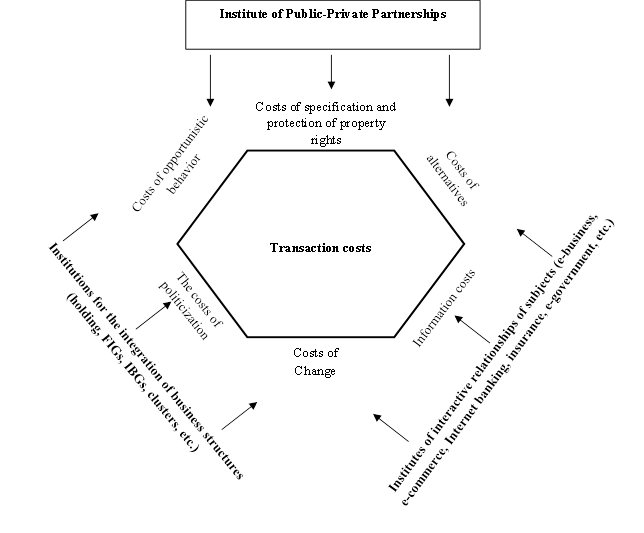
Institutional integration of business structures (holdings, financial and industrial groups, integrated business groups, clusters) is the institutional framework, that regulates the transaction costs of opportunistic behavior. The authors distinguish this form of integration as clusters with respect to the Kaliningrad region.
Problem Statement
We will consider clusters from the position of the institutional approach.
It is not accidental that a “cluster” is formed as a community of firms are closely related to industries and contribute to the growth of each other's competitiveness. Clusters are the “points of the growth” of the industry and the basis for international expansion. In the economy, as a rule, after the first cluster new ones are created, the country's competitiveness on the international market is growing. Today, the high competitiveness of developed countries is based on the positions of individual clusters. In the process of cluster formation, its production starts to support each other. Accordingly, the benefits are distributed among all participants. New producers – cluster members coming from other industries, accelerate its development, stimulating innovative approaches and providing the means necessary to implement new strategies. There is a free exchange of information. Connections within the cluster generate new opportunities and prospects. In turn, human resources generate ideas and create new combinations. Thus, the cluster becomes a means of overcoming isolation on regional problems, inflexibility, inertia and corruption, which can reduce, and in some cases even block, the positive impact of competition.
Consequently, the cluster allows for transactions to be more profitable, significantly reducing transaction costs. If there is a whole cluster of industries, there is an acceleration of the process of formation of factors where domestic competitors are present. Cluster firms from related industries invest in related technologies, human resources, infrastructure, which initiates the creation of new enterprises and organizations. The cluster is a kind of catalyst for large investments with the close attention of the government. The economic resources of isolated industries that do not use them productively to flow into the cluster.
You can imagine a cluster in the form of a pyramid, which includes three levels. The first is the leading firms exporting products and services outside the region. The next level is a network of supplies, these are small and medium-sized companies that supply components and/or services to leading companies, they constitute the so-called ecosystem. The third level is social and economic infrastructure, business climate. These are different organizations, that provide key companies with infrastructure, human and financial resources.
The cluster center, as a rule, is made up of several powerful firms. Competitive relations remain between them. Accordingly, the cluster should not be confused with financial group or a cartel. The cluster creates the most favorable conditions for accelerated growth of specialized production, supporting and servicing, as a promising market for venture and other innovative companies is formed. In consequence, these are generators of competitive advantages of clusters. Providing small supplies with orders for simple components, the cluster copies its structure to the national community of companies with one important difference: it gathers leading companies in the region, countries that determine its international competitiveness.
Mechanisms, which facilitate interchange within the cluster, between the companies in different industries are conditions that facilitate the coordination of interest of firms linked horizontally and vertically, and free movement of information. Factors that accelerate the movement of information are the personal relationships that arise as a result of joint learning; communications, due to geographical proximity and industry association; corporate standards of conduct. Factors, that determine the coincidence of goals, as well as the compatibility within the cluster: common ownership of the industrial group; participation in joint-stock ownership; personal and family ties between firms within the cluster, and some others.
Clusters are located, as a rule, in one region. Concentration of competitors (producers and buyers) directly affects the increase in the efficiency of specialization. More significant is the positive impact of geographical concentration: first, on the development of production processes, and secondly on the introduction of innovations within the cluster.
The main mechanism for the development of the cluster is the symbiosis of competition and cooperation. Because of the competition within the cluster, its system is optimized, and due to the inflow of information, the exchange of specialists and technologies, the financial resources are shifted to the most necessary sectors for its development.
The use of cluster organizational technologies is an effective strategy to increase the competitiveness. Cluster can be considered as a model of public-private partnership. Cluster projects have a different scale: from microclusters that form within the technology parks at universities, to transnational clusters that unite thousands of participants.
Unfortunately, cluster technologies in the Russian Federation are applied narrowly. The exception is the regional level clusters. In Russia, there is often a lack of a clear understanding of the practical effectiveness of clusters: cluster technologies are perceived by the leaders of the territories in an abstract manner, applicable exclusively to foreign countries.
In the Russian Federation clusters call many entities: the holding companies, the association of companies, the business incubator, the industrial park, the special economic zone (SEZ), and the territory of advanced development (TAD).
In our country there are separate potential regional clusters. For example, an automobile cluster in the Samara region, a cinema cluster in the Moscow region and others.
The first step in our study to implement a cluster project in the region was to conduct a marketing study. Based on this, conclusions were drawn about the potential competitiveness of the fisheries cluster. In the process of identifying strategically important areas of activity of this cluster, statistical data on the development of the region, the entire set of regional enterprises (large, medium and small) were analyzed; the dynamics of small businesses are separately singled out; the main indicators of production, economic and financial activities all the regional enterprises, as well as individual segments, its export-import balance, territorial distribution of companies and their products by industry.
Research Questions
Given the gap in the existing literature, research questions for this present study are:
To what extent does socio-economic development affect the degree of development of the region?
What factors determine the correct structure and development of the fisheries cluster in the Kaliningrad Region?
Purpose of the Study
The objectives of this study are:
To study the factors influencing the competitiveness of the exclave region;
To develop the institutional basis of the cluster system of the fishery complex of the Kaliningrad region.
Research Methods
The economy of the Kaliningrad region has a fairly high degree of diversification, as evidenced by the structure of the gross regional product. In the region there are no clusters and industries monopolizing the main economic trends of its development. This is a sign of the stability of the regional economic system, suggesting the existence of a fairly effective layer of small and medium-sized businesses. At the same time, the lack of large-scale production and service industries, coupled with increased competition in the Baltic region, sharply limits the opportunities for macro-regional positioning (Decree of the Government of the Kaliningrad Region of 08.07.2016 N 341, 2016).
Although fisheries account for less than 0.5% of the global economic product, they constitute an essential economic activity in many parts of the world (World Bank and FAO, 2009) particularly in the sparsely populated but relatively affluent sub-Arctic regions of the globe and several coastal communities in Europe and North America. To date, however, the role of fisheries in national and regional economies is not well understood (Morrissey & O’Donoghue, 2013). What has been established is that the fishing industry generally constitutes a base industry within regions. Briefly stated; a base industry is an industry that is capable of operating without the support of other local industries (Roy et al., 2009; North, 1955). As such, base industries are often founded on natural resources found in the region (Sigfusson, Arnason, R., & Morrissey, 2013).
Analysis of socio-economic development indicators of the Kaliningrad Region
Let us dwell on the socio-economic indicators of the development of the Kaliningrad region (see Table
Note: Source: compiled by the authors according to Rosstat (http://www.gks.ru/)
In 2015, GRP per capita was at the level of 338 thousand rubles per person (in the NWFO - 490 thousand rubles, in the Russian Federation - 445 thousand rubles). In 2016, the GRP index was 99.2% at constant prices to the level of 2015. In 2016, the GRP of the Kaliningrad region per capita, according to a preliminary estimate of the Ministry of Economy of the Kaliningrad region, formed at the level of 348 thousand rubles per capita. The preliminary permanent population as of the beginning of 2017 was 986,289 people and increased in January-December 2016 by 9,850 people.
Dynamics of the gross added value of the Kaliningrad region for 2011-2015 is showed in Figure
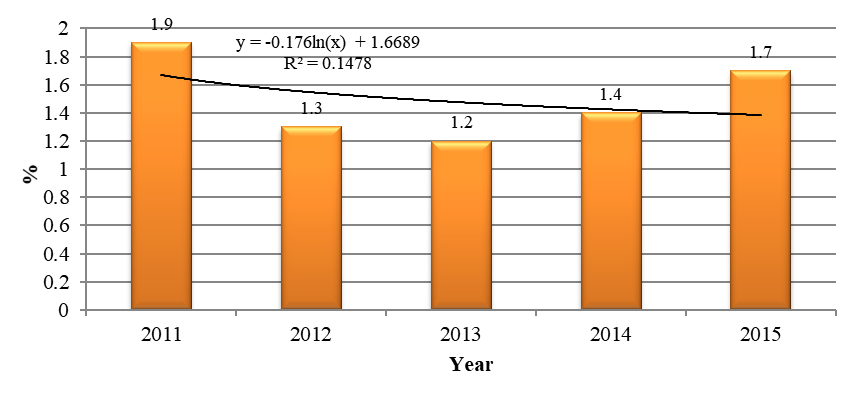
-
Assessment of the competitiveness of the region: the factors of the problem and the prerequisites for the development of the fisheries cluster in the Kaliningrad Region
Exclave nature of the Kaliningrad region and its remoteness from the mainland territory of the Russian Federation by the borders of foreign states creates for it significant competitive problems that hamper development, in comparison with the other regions of the Baltic Sea and the Russian Federation.
So the main problems of the Kaliningrad region today are:
low level of industrial production;
physically and morally obsolete equipment;
orientation of almost all manufactured products to the market of the Russian Federation;
poorly developed economic infrastructure and high wear and tear;
unsolved problems in the energy complex;
stagnant environmental problems;
unsolved problems with flooding of a part of the territory in the Kaliningrad region;
loss of agricultural areas due to low attractiveness of this industry.
In order to solve the above problems, the state program of the Russian Federation “Socio-economic development of the Kaliningrad region until 2020” (Order of the Government of the Russian Federation of 17.11.2008 N 1662-р, 2008). was developed, and a number of subprograms that identified the need to address such tasks as the development of the infrastructure of the Kaliningrad region, the creation of competitive sectors of the economy, improvement of living standards of the population, development of tourism and mobility of the population. In particular, in order to achieve the objectives, one of the priority areas is the creation of a network of clusters (Decree of the Government of the Russian Federation of 07.12.2001 N 866, 2001).
For effectively socio-economic development of the Kaliningrad region, it is necessary to provide the conditions for the development of the engineering infrastructure of the newly formed clusters in the Kaliningrad region. In this regard, the government of the Russian Federation has created a mechanism for public-private partnership that allows improving the positive investment climate in the Kaliningrad region and attracting both domestic and foreign investors, while creating conditions for the formation of personnel for production clusters, etc. (Decree of the Government of the Kaliningrad Region of 25.03. 2014 № 144, 2014).
Despite existing obvious problems, the Kaliningrad region has all the prerequisites for creating a fisheries cluster:
presence on the territory of the region of at least ten fisheries enterprises, at least one enterprise that carries out final production;
presence of infrastructure facilities, educational and scientific institutions and other organizations (FSBSI “AtlantNIRO”, FSBEI HE “Kaliningrad State Technical University”, FSBEI HE “Baltic State Academy”, etc.), connected by cooperative links with fisheries enterprises;
there is a large number of joint projects between the participants of the future cluster.
In the addition to the above factors, the region has also additional factors that contribute to the development of the proposed cluster:
there is a positive trend and a favorable outlook for the development of core markets;
there is an intensive formation of local small and medium-sized companies in the fisheries industry;
the region has investment attractiveness, and there are free territories for basing the future cluster. Private investors interested in creating a fisheries industry cluster are looking to the region.
Below in Figure
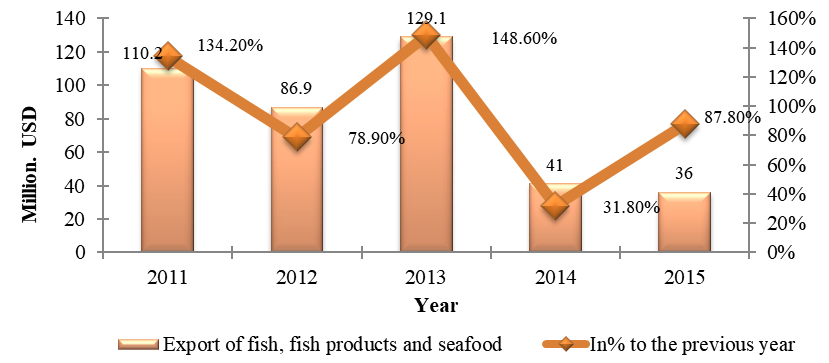
Analysis of Figure
The same dynamics can be seen on Figure
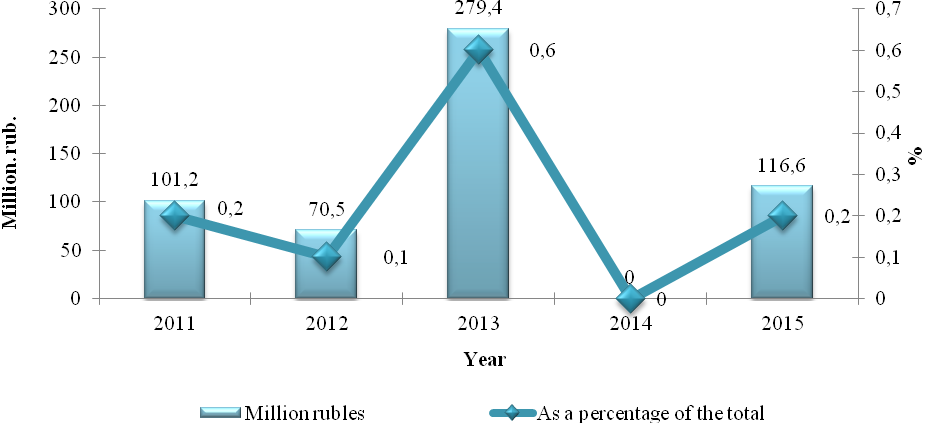
Along with the above-mentioned indicators, we can also observe a significant decline in the labor productivity index for the industry of fisheries and fish farming in Russia in 2008-2016 (see Figure
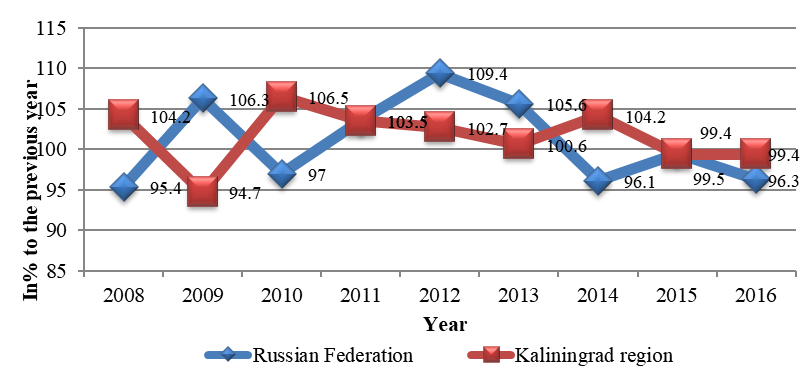
Along with the above-mentioned indicators, we can also observe a significant decline in the labor productivity index for the industry of fisheries and fish farming in Russia in 2008-2016 (see Figure
According to the OECD, in 2016 in Russia, the contribution of one worker to the country's GDP $ 23.9 US per hour, but in OECD countries – $ 46,7 US per hour. In the opinion of the President of the Russian Federation V. V. Putin it is necessary to boost the labor productivity forcefully, at least by 5-6% each year. He stressed, that together with the regions, enterprises, and business it is necessary to build a clear working system to support employment and labor mobility.
Meanwhile, the number of high-productivity jobs in the fisheries industry in the Kaliningrad region has slightly increased, but in general for the Russian Federation this indicator tends to decline (see Figure
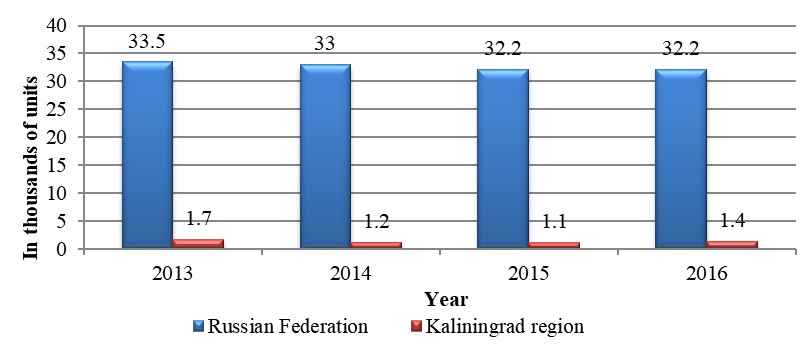
Analysis of the dynamics of the development of the fisheries industry in the Kaliningrad region shows that it is now the situation is acute and it is necessary to take prompt measures to bring the industry out of the crisis.
Findings
In order to remedy the situation, the federal center jointly with the administration of the Kaliningrad region have developed a number of initiatives aimed at stimulating business development in the region. Substantial changes were made to certain legislative acts of the Russian Federation on the socio-economic development of the Kaliningrad region.
Possessing a favorable geographical location and using the updated package of legislative innovations on the Special Economic Zone (SEZ), tax preferences and benefits, which come into effect on January 1, 2018, the effeciency of the activities of companies and investors in the fisheries cluster increases more qualitatively, which in turn makes the region the most profitable territory for doing business in Russia (Federal law of 05.12.2017 N 393-FL, 2017).
The result of the study was a primary analysis of competitive product lines, where a positive role of small business was revealed. As a result, the rationale for choosing a fisheries cluster in the Kaliningrad region was confirmed.
Further, it is necessary to develop a system of performance indicators for proposed cluster project. Cluster organizational technologies will successfully solve the problem of increasing competitiveness, improve the export-import balance of the region. The main result of this project will be the improvement of the regional trade balance, export growth and import substitution. Among the indicators of the efficiency of the cluster project, we can single out the positive dynamics: the main indicators of the financial and economic activities of the cluster participants; tax revenues, investments, including foreign ones; number of organizations and enterprises of the cluster; the share of the sector of small and medium-sized enterprises in the cluster project; increase in the share of the innovative product in the total output of the cluster; growth of skilled jobs, etc.
Then, it is necessary to conduct an in-depth analysis of the selected areas, which will help clarify the system of project objectives and create a schedule for the creation of the cluster, identify key activities, performers, cost estimates, funding sources. As a result, the cluster project is disaggregated to the level of subprojects.
The cluster project is of a purely practical nature. The development of small business in the process of implementing the activities of the cluster project is a subordinate task, but at the same time, during the cluster project, small businesses are actively developing in the region.
Cluster state policy is quite complex. It is implemented at different levels, which requires coordinated actions by both federal and regional authorities. Now there is a third level - interstate. The Baltic countries Finland, Sweden, Norway, and Denmark can be cited as an example, which is very important for the Kaliningrad region.
Further, the success of the cluster approach is determined by how fully it will be possible to attract those, who should be interested in the project, who is capable of real contribution to the development of the region. They are representatives of industry, business community, public authorities, public organizations and associations, which are connected by a complex network of various interactions. Most of them are reoriented to social partnership, for the purposes of strategic regional development.
We conclude that the cluster is a fundamentally new element in the structural integration of business structures, an informal association of enterprises. From the set of approaches, we single out its general characteristics, namely: the territorial community of firms, their interrelation and specialized orientation.
It is necessary to clarify that the integration forms of economic interactions of various business levels from small to large do not have the following features of cluster system:
the presence of the leader — the leading enterprises that determines the strategy for the development of the entire system;
territorial localization of the majority of participants in the cluster project;
stability and long-term coordination, the dominant importance of economic ties between economic entities – participants of the cluster system.
Let's present the author's position on the structure of the fisheries cluster of the Kaliningrad region (see Fig.
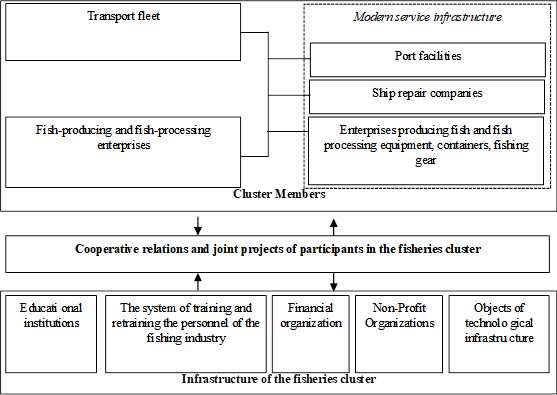
Cluster policy focuses on strengthening the relationships between the cluster members. Not only the leaders of the cluster, but also, as can be seen from its structure (Figure
Clusters are distinguished by a complex combination of cooperation and competition. They are located in various planes, complementing each other, and, first of all, in the field of innovative processes. The cluster interacts with the external consumer of products, services on the terms of cooperation, but with the internal, on the contrary, on the terms of competition. Clusters are present in the world market as unified agents of competition and networks, this allows them to resist the tendencies of global competition, and the innovation policy implemented by them through corporate means significantly reduces transaction costs.
It should be noted the following trend of development of cluster system, developed in recent decades, - inter-firm cooperation of enterprises of the small business segment. The basic principle in it is the principle of horizontal cooperation. In order to strengthen specialization and increase competitiveness, small enterprises with approximately the same production capacities are united. These groups of small enterprises actively cooperate among themselves, realizing the declared goal in the project, and at the same time receive economies of scale because transaction costs are reduced. Mobile clusters, which unite many small businesses, successfully compete with large firms, forming local production systems. The territories where such small firms are located begin to play the role of a paradigm for the development of the region. Export-oriented clusters create opportunities for firms entering into them to improve the quality of products, which allows to significantly increase the share of presence in world markets.
It is important to form the cluster as much as possible to take into account the interests of all participants, relying on the law of primary personal interest. Only the unification and coordination of the directives of the system with the personal interests of its participants will ensure its effective functioning. Otherwise, this will weaken the position of the cluster as a whole. A similar problem arises with the artificial creation of systems by a solution from above, it can be solved through natural communications.
Returning to the question of determining the institutional framework for regulating transaction costs in the fisheries sector of the region, we rely on the study (Figure
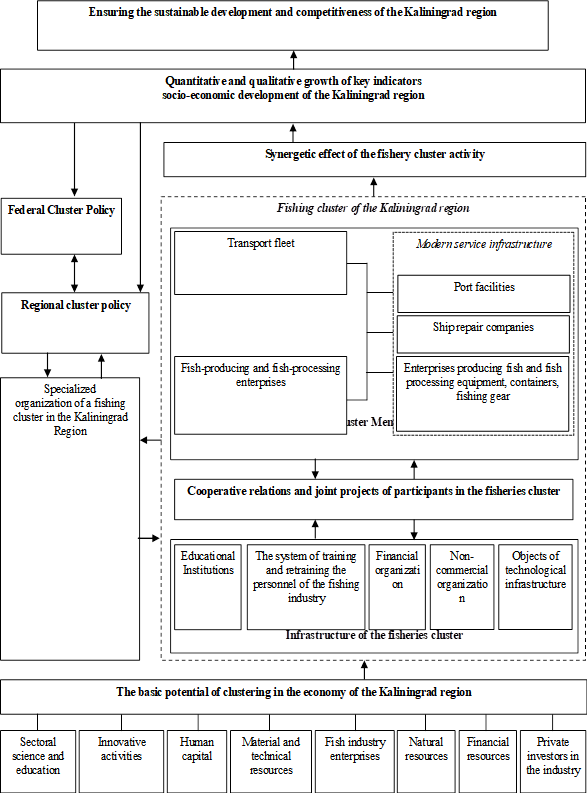
To activate the creation of a fisheries cluster, the authors of the article developed a model of the influence of the cluster entities on the formation of sustainable development in the Kaliningrad region.
The infrastructure includes not less than:
1 institution of HPE or ACT;
2 objects of technological infrastructure;
1 non-profit organization;
1 financial institution.
Using the mechanism of quantitative and qualitative control of the growth of the main indicators of the socio-economic development of the Kaliningrad region, in conjunction with the most important target indicators and indicators of various regional programs, strategies and regional development forecasts, an effective clusterization model of the regional economy can be created and sustainable development of the region based on the synergetic effect in all branches.
To control the quality of cluster groups and assess the formed economic agglomerations, it is necessary to use the "Localization coefficient" proposed by Porter (2012), which is calculated by the following formula:
(1)
Where
LQ - "Localization coefficient";
Empig - the number of employees in sector i in region g;
Empg - total number of employees in the region g;
Empi - number of employees in the industry i;
Emp - the total number of employees.
If the "localization coefficient" is greater than one, then this industry prevails in the economy of the region. Porter (2012) often uses a threshold value of 0.8 in his works. Such authors as E. Bergman and Feser (1999) recommend using the "localization coefficient" more than 1.25. In turn, experts note that the optimal value is more than 1.25, since this affects the importance of cluster groups and their number.
In the following papers of the authors of this article, the "Coefficient of localization of the Kaliningrad region" will be investigated, cluster groups analyzed and the estimated economic agglomerations in the region assessed. The authors will continue studies of the aspects of sustainable development of the Kaliningrad region and will point to the most optimal directions in the formation of cluster entities in the region.
Conclusion
Exclave nature of the Kaliningrad region and its remoteness from the mainland territory of the Russian Federation by the borders of foreign states creates for it significant competitive problems that hamper development, in comparison with the other regions of the Baltic Sea and the Russian Federation.
The economy of the Kaliningrad region has a fairly high degree of diversification, as evidenced by the structure of the gross regional product. In the region there are no clusters and industries monopolizing the main economic trends of its development. This is a sign of the stability of the regional economic system, suggesting the existence of a fairly effective layer of small and medium-sized businesses. At the same time, the lack of large-scale production and service industries, coupled with increased competition in the Baltic region, sharply limits the opportunities for macro-regional positioning.
Thus, the choice of cluster structuring of the economy of the Kaliningrad region as an institutional framework will significantly increase its competitiveness. This will make it possible to translate the regional fisheries complex into an innovative way of development, support science and education, expand export activities, create a modern necessary infrastructure, and improve the quality of life of the population
The authors believe that the institutional integration of business structures into a fisheries cluster is the most acceptable form of development for the Kaliningrad region.
Acknowledgments
The authors of the article express their gratitude to the head of the "Federal Agency for Fisheries" Shestakov Ilya Vasilyevich and vice-rector for scientific work "Kaliningrad State Technical University" Kostrikova Natalia Anatolyevna for positive criticism and support of this study.
References
- Allen, D. W., & Coase, R. H. (1991). The Firm, The Market, and The Law. The Canadian Journal of Economics, 24(3), 740-743. DOI:
- Bergman, E. M., & Feser, E. J. (1999). Industrial and Regional Clusters: Concepts and Comparative Applications. Morgantown, WV: Regional Research Institute, West Virginia University. Retrieed from URL: http://www.rri.wvu.edu/WebBook/Bergman-Feser/contents.htm.
- Coase, R. H. (1988). The Firm, The Market, and The Law. Chicago, IL: University of Chicago Press.
- Decree of the Government of the Kaliningrad Region of 08.07.2016 N 341 (2016). «On the forecast of the socio-economic development of the Kaliningrad region for a long-term period until 2030». Kaliningradskaja Pravda (insert "Official Gazette of the Government of the Kaliningrad region"). 129. [in Rus.].
- Decree of the Government of the Kaliningrad Region of 25.03.2014 № 144 (2014). "On the state program of the Kaliningrad region" Development of industry and entrepreneurship". Kaliningrad truth (insert "official Bulletin Of the government of the Kaliningrad region"). 74. [in Rus.].
- Decree of the Government of the Russian Federation of 07.12.2001 N 866 (2001) "On the Federal Target Program for the Development of the Kaliningrad Region for the Period to 2020". Meeting of the legislation of the Russian Federation, 52 (2). [in Rus.].
- Federal law of 05.12.2017 N 393-FL (2017). «On amending certain legislative acts of the Russian Federation on the issues of social and economic development of the Kaliningrad Region». Rossiyskaya Gazeta - Federal issue, 7445 (279).
- Morrissey, K., & O’Donoghue, C. (2013). The role of the marine sector in the Irish national economy: An input-output analysis. Marine Policy. 37, 230-238. DOI: 10.1016 / j.marpol.2012.05.004.
- North, D. C. (1955). Location Theory and Regional Economic Growth. Journal of Political Economy, 63(3), 243–258. DOI:
- Order of the Government of the Russian Federation of 17.11.2008 N 1662-р (2008). «On the Concept of Long-Term Social and Economic Development of the Russian Federation for the Period to 2020» Collection of legislation of the Russian Federation, 47. [in Rus.].
- Porter, M. E. (2012). The economic performance of regions. Regional Competitiveness, 2, 131-160 DOI:
- Polyakov, R.K. (2017). The Fishing cluster of the Kaliningrad region is a missing mechanism and a connecting link in the industry. Fish industry, 4, 42-47.
- Roy, N., Arnason, R., & Schrank, W. E. (2009). The Identification of Economic Base Industries, with an Application to the Newfoundland Fishing Industry. Land Economics. 85(4), 675-691. DOI:
- Sigfusson, T., Arnason, R., & Morrissey, K. (2013). The economic importance of the Icelandic fisheries cluster-Understanding the role of fisheries in a small economy. Marine Policy. 39(1), 154-161. DOI:
- Williamson, O. E. (1985). The Economic Institutions of Capitalism: Firms, Markets, Relational Contracting, New York: The Free Press.
- World Bank and FAO. (2009). The Sunken Billions. The Economic Justification for Fisheries Reform. World Bank, Washington, DC. FAO, Rome. DOI: 10.1596/978-0-8213-7790-1.
Copyright information

This work is licensed under a Creative Commons Attribution-NonCommercial-NoDerivatives 4.0 International License.
About this article
Publication Date
20 March 2019
Article Doi
eBook ISBN
978-1-80296-056-3
Publisher
Future Academy
Volume
57
Print ISBN (optional)
-
Edition Number
1st Edition
Pages
1-1887
Subjects
Business, business ethics, social responsibility, innovation, ethical issues, scientific developments, technological developments
Cite this article as:
Stepanova, T., & Polyakov, R. (2019). Transaction Costs And Their Impact On The Development Of The Fisheries Cluster. In V. Mantulenko (Ed.), Global Challenges and Prospects of the Modern Economic Development, vol 57. European Proceedings of Social and Behavioural Sciences (pp. 497-512). Future Academy. https://doi.org/10.15405/epsbs.2019.03.49

